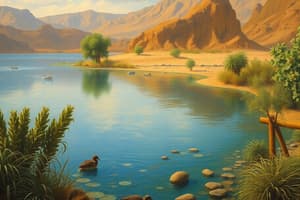Podcast
Questions and Answers
What are the different types of desert ecosystems based on temperature and rainfall?
What are the different types of desert ecosystems based on temperature and rainfall?
Hot and dry, semiarid, coastal, and cold deserts
Describe the structure of desert ecosystems.
Describe the structure of desert ecosystems.
Desert ecosystems have sparse and scattered vegetation, including cacti, succulents, shrubs, and grasses.
What are the main producers in desert ecosystems?
What are the main producers in desert ecosystems?
Plants and algae
List some examples of consumers in desert ecosystems.
List some examples of consumers in desert ecosystems.
How do producers in desert ecosystems make their own food?
How do producers in desert ecosystems make their own food?
What unique features and resources do desert ecosystems have?
What unique features and resources do desert ecosystems have?
Explain why desert ecosystems are considered dry systems.
Explain why desert ecosystems are considered dry systems.
How do desert ecosystems help in storing water?
How do desert ecosystems help in storing water?
What are some functions and services provided by desert ecosystems?
What are some functions and services provided by desert ecosystems?
Why are desert ecosystems important despite their harsh conditions?
Why are desert ecosystems important despite their harsh conditions?
Flashcards are hidden until you start studying
Study Notes
Desert Ecosystems Overview
- Characterized by low interaction among living and non-living components: limited predation, competition, and symbiosis.
- Functions of deserts include heat storage, light reflection, climate regulation, soil erosion prevention, water purification, habitat provision, and biodiversity support.
Importance of Desert Ecosystems
- Essential for human well-being and planetary health due to their ecological functions.
- Contribute economically with resources such as minerals, oil, and solar energy, utilized across various sectors.
Threats to Desert Ecosystems
- Facing significant challenges from desertification, drought, overgrazing, mining activities, agriculture, and climate change.
- Human actions lead to reduced size, quality, and biodiversity of deserts.
Conservation and Management Strategies
- Implemented strategies for preservation: irrigation, afforestation, ecosystem restoration, protection measures, sustainable resource use, and educational initiatives.
- Aimed at enhancing the resilience and functionality of desert ecosystems.
Human Benefits from Desert Ecosystems
- Offer recreational opportunities, tourism potential, avenues for research, and educational experiences, enriching human understanding and interaction with the environment.
Characteristics of Deserts
- Defined as regions receiving less than 25 centimeters (10 inches) of rainfall annually, with periods of prolonged drought.
- Temperatures vary significantly between day and night; deserts can be extremely hot or cold.
- Composed mainly of sand, rocks, or salt, with scarce vegetation, including limited trees and grasses.
- May contain mountains or hills and are home to specially adapted plants and animals.
Unique Adaptations in Desert Flora and Fauna
- Cacti have thick stems for water storage and spines for protection.
- Camels possess fat-storing humps and long eyelashes to shield against sand.
Ecological and Climate Role of Deserts
- Deserts play a crucial role in maintaining climate balance and the global water cycle.
Understanding Water Budgets
- Water budgets quantify the inflow and outflow of water in various systems (e.g., watersheds, aquifers).
- Essential for assessing water availability, movement, and the impact of human activities and climate change on water resources.
Studying That Suits You
Use AI to generate personalized quizzes and flashcards to suit your learning preferences.




